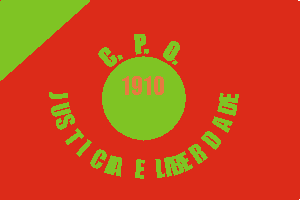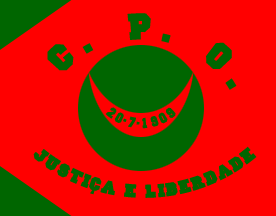
Last modified: 2014-12-12 by klaus-michael schneider
Keywords: disc (green) | centro democratico federal | 15 de novembro | c.p.o. | justiça e liberdade | 1910 | carboneria | carbonária |
Links: FOTW homepage |
search |
disclaimer and copyright |
write us |
mirrors
The republican revolution of 1910 (and previous attempts and
demonstrations) was largely inspired by a radical republican secret society
called Carbonária (akin to the Masonry), inspired in an
older Italian organization of the same name. These called themselves the
charcoal-makers (carbonari), who were free to go out of town to the
forests get their wood… and conspire at will away from the
landlord’s spys — hence the alias The Forest Masons
(Maçonaria Forestal). Being Saint John the patron of
charcoal-makers, red and green was also their
colour, both of genuine
charcoal-makers guild and of the later secret society, and later the
colour of Portuguese radical republicans…
António Martins-Tuválkin, 19 Feb 1998
I didn’t know the Carbonari existed
outside of Italy. The Carbonari flag was horizontal stripes of blue
(top), red and black, representing the burning charcoal.
Dave Martucci, 22 Feb 1998
Portuguese Carbonarians (namely Associação 31 de Janeiro,
in Oporto) used a red flag with a green circle and some lettering. I was
told these are based on (charcoal maker’s patron) St. John.
António Martins-Tuválkin, 3 Mar 1998

The flag of the Centro Democrático Federal «15
de Novembro»; approx.
1:2 red field with green disc, on it "15 / DE / NOVEMBRO",
red, in three lines, and arched above, in larger green letters,
"CENTRO DEMOCRATICO FEDERAL" (no accent mark).
António Martins-Tuválkin, 15 Mar 2000
This is an important flag for the history of the current portuguese
national flag.
The Centro Democrático Federal 15 de Novembro (Democratic Federal Center
November 15) is a political gathering of republicans in Oporto in the late
XIX century, whose members were especially active during the republican
uprising in that city in January 31, 1891.
More information about the center and the influence of its flag in the
portuguese national flag can be found in the following excerpt of an
article by Nuno Severiano Teixeira on the origin of the portuguese symbols
that can be found at the website of the portuguese Presidency, at
http://www.presidenciarepublica.pt/pt/republica/simbolos/simbolica.html .
(My comments between square brackets).
"[...] there is no confirmation that the green and red in the republican
flag comes from these predecessors [previous portuguese flags with those
colours]. The most direct predecessor has to be found much later, in the
end of the XIX century: the flag of the republican uprising in Oporto in
January 31, 1891.
The flag flown from the Oporto city hall in the morning of January 31,
1891, symbol of the republican uprising, was, indeed, red and green.
Totally red with a green circle in the center, to which were added the
inscriptions referring to the republican center to whome it belonged - the
Centro Democrático Federal 15 de Novembro.
This flag, known by the rebels as the red flag [...] is, in its symbolic
essence, the flag of the revolutionary and popular tradition. Firstly the
symbol of the Cartism in England, it would be later flown in Paris during
the revolution of 1848 and the Commune of 1870.
To the red background of democratic and trade union traditions are added
various insignia and inscriptions, characteristic of the political clubs
they belonged to. That's the origin of the vast majority of the flags of
the republican centers, like that of the Centro Republicano Federal 15 de
Novembro.
What is certain is that the first flag for the Republic that was flown in
Portugal was red and green. When the Oporto revolution failed, the
verde-rubra [green-red - an expression that later became a nickname for
the portuguese national flag] flag becomes, to the republicans, the
fundamental mark, the symbol of the Republic, for the moment vanquished but
never giving up and which, after twenty years of struggle would triumph,
after a sequence of actions prepared by the Republican Party.
That's all there is to it. The flag is red, with a green disc in the center
containing the inscription “15 / DE / NOVEMBRO”, in red capitals, and an
arc above the disc containing the rest of the club's name: “CENTRO
DEMOCRÁTICO FEDERAL”, in yellow capitals.
Jorge Candeias, 19 Feb 2005

Flag shown in the cover of the book La revolución Portuguesa (The
Portuguese revolution), by J. Brissa, edited in Barcelona in 1910.
Santiago Dotor, 14 Mar 2000
I have no idea about the green triangle on this flag from Brissa’s
book. All other differences (wording and ratio) seem
to be variants of a popular design. "C.P.O." might mean "Centro Popular
Operário" (Worker’s People’s Center).
António Martins-Tuválkin, 15 Mar 2000 and Dec 2001
 image by António Martins-Tuválkin, 29 June 2009
image by António Martins-Tuválkin, 29 June 2009
This banner was presented in 1910 to a foreign newspaper as being the new Portuguese national flag.
The reconstruction is based on a fragment of a photo published in the Argentine "La Nación".
António Martins-Tuválkin, 29 June 2009